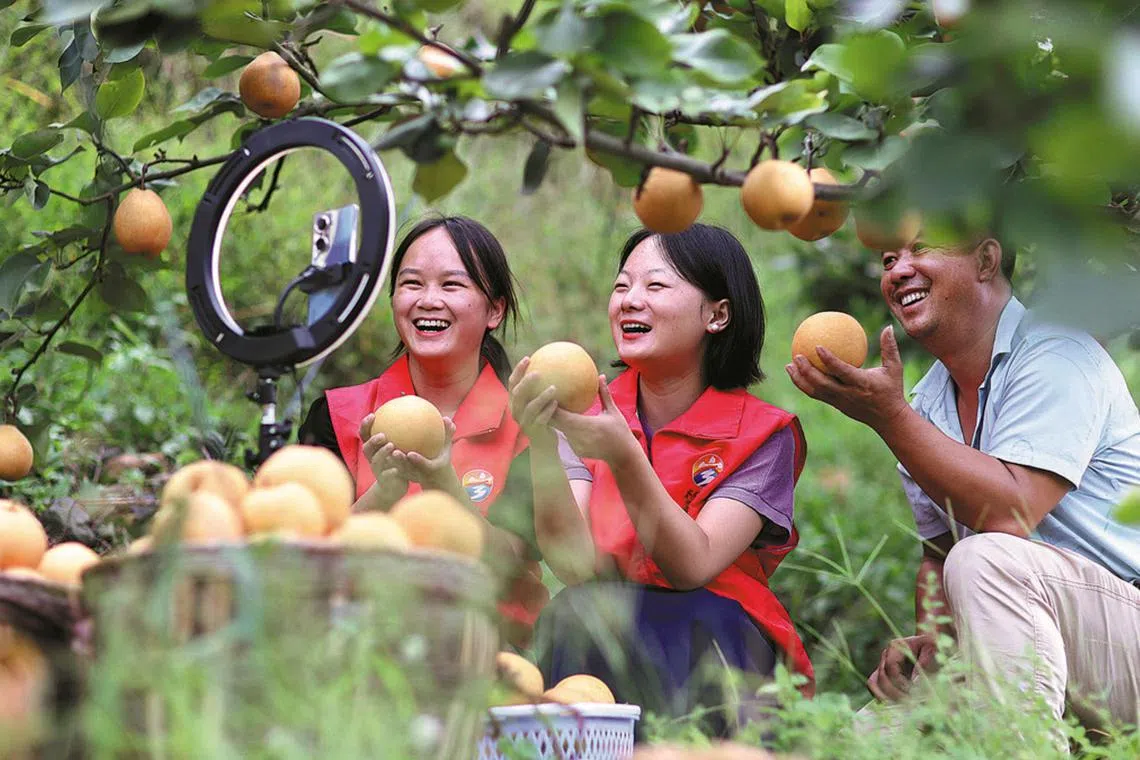Village vloggers in China cash in on live streaming
Sign up now: Get ST's newsletters delivered to your inbox

More than 870 million yuan (S$164 million) worth of farm produce was sold on the Kuaishou platform in 2022 through village live broadcasts, up 55 per cent year-on-year.
PHOTO: CHINA DAILY/ASIA NEWS NETWORK
Follow topic:
QINGHAI – Ms Geru Drolma began digging for fungi in the Qinghai-Tibet plateau at the age of six, following in the footsteps of her ethnic Tibetan parents, as her family eked out a meagre living from sales to nearby shops.
Fourteen years later, she shot to stardom when a video of the arduous work that she posted online attracted half a million viewers, putting her on the path to prosperity.
In May 2017, Ms Drolma, then 20, and her mother ventured into the snowcapped landscape near their home in Daocheng county, in Sichuan province’s Ganzi Tibetan autonomous prefecture, in the hope of unearthing a lot of cordyceps. The fungus, native to the region, grows on the bodies of caterpillars and is used in traditional Chinese medicine.
Ms Drolma shot a video of the process on her mobile phone to share on Kuaishou, a short video app she had downloaded a few months earlier.
The next day, when she logged on to her Kuaishou account, she was stunned. The cordyceps video had been viewed 500,000 times, and she had 3,000 new followers. Her inbox was overwhelmed with messages asking about the price of cordyceps.
She said she was amazed that the “dull routines of my life could be something interesting for others”.
Ms Drolma, who now has 2.2 million followers on Kuaishou, decided to cash in on her newfound fame by live-streaming about local farm produce – an increasingly popular online marketing strategy.
The business was so successful that in 2019, she started a cooperative with her husband to supply their live-streaming channel with a constant flow of content about local specialities. “Our clients place millions of orders online each year, and the revenue of our cooperative can reach 5 million yuan (S$943,000) a year,” she said.
She is among a growing number of farmers riding the wave of China’s e-commerce live-streaming boom.
Assisted by better telecommunication infrastructure in once-isolated hamlets and cheaper courier services, the farmers-turned-hosts bypass middlemen to pitch their agricultural products directly to deep-pocketed customers thousands of kilometres away.
Such videos have even led to the creation of a new genre of clips on Kuaishou and other short video platforms. These village live broadcasts are known in Chinese as “cunbo”.
In a report released in September, Kuaishou said more than 870 million yuan worth of farm produce was sold on the platform in 2022 through village live broadcasts, up 55 per cent year on year.
It said more than 300 million users had been identified as being interested in content with rural themes.
In January, Kuaishou launched a village broadcaster training programme that aims to promote China’s rural revitalisation campaign by helping village vloggers get more exposure.
The company said it trained 100,000 rural residents in live broadcast skills in the first half of 2023, equipping them with the skills needed to live-stream about rural life, and promote sales of farm produce or traditional handicraft designated as intangible cultural heritage.
The effort has created 250,000 jobs in about 25,000 townships nationwide, it added.
The economic potential of rural-themed videos and live streams has also been recognised by the authorities.
In August, the Ministry of Commerce released a three-year action plan to boost e-commerce in China’s counties and surrounding villages.
As part of the plan, grassroots authorities were asked to encourage e-commerce live streaming and cultivate local trademarks.
Ministry figures show that online retail sales of rural products topped 1.12 trillion yuan in the first half of 2023, up 12.5 per cent year on year.
In August, after floods and other extreme weather events battered many parts of China, the National Rural Revitalisation Administration issued a circular calling for greater efforts to ensure financially vulnerable rural families did not suffer.
Among the many measures it outlined, the circular encouraged the purchase of agricultural products from affected regions, and said organisations funded by public money needed to collaborate with e-commerce enterprises to support the expansion of farm produce sales.
“Efforts are needed to guide financially strapped households in transforming their products into marketable goods and tangible cash, ultimately promoting stable employment and income growth,” it said.
CHINA DAILY/ASIA NEWS NETWORK

